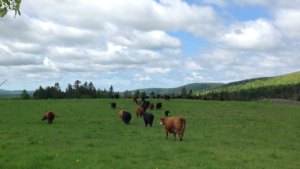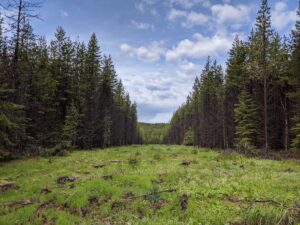Seeing the Forest Through the Trees: Tips for Forest Grazing Cattle 🎙️
CLICK THE PLAY BUTTON TO LISTEN TO THIS POST:
Listen to more episodes on BeefResearch.ca, Spotify, Apple Podcasts, Amazon Music or Podbean.
Forested rangelands and partially or completely forested areas are widespread in many areas of Canada. The benefits of using forested areas in grazing includes increased pasture acres, temporarily or permanently, while providing protection for livestock from the elements.
The integration of livestock into agroforestry systems has many benefits for both the livestock and the environment including fire suppression/prevention by reducing fuel load on the forest floor, shade and protection for livestock, protection from winter winds and other inclement weather patterns, provides wildlife habitat, diversification opportunities, carbon sequestration and opportunities to rest other pastures.
While forest grazing can offer many benefits to the land and the animals, some risks exist and must be managed for, such as impacts on forest regeneration, altered forest composition, water quality, compaction and erosion.
Forest grazing can provide resources including shelter, forage, and browse for livestock. Protecting and preserving Canadian forests requires producers to comply with local, provincial and federal regulations. While basic principles of grazing management such as using appropriate stocking rates, controlling weeds, avoiding damage to sensitive areas and monitoring animal condition apply, some additional considerations are suggested when implementing forest grazing.
Tips for forest grazing:
- start on a small scale to monitor and assess results
- conduct a site assessment to determine resources available, including soil type and dominant tree species
- contact local government offices for regional information and woodlot groups and associations to learn best management practices for local conditions
- determine a plan to best utilize the forested area, such as integrating cattle into the forest or silvopasture
- have a back-up plan to provide adequate forage for livestock
- if seeding forages in forested areas, remember that warm season grasses (C4) perform poorly in shade, while cool season grasses (C3) have better shade tolerance and generally perform better
- do not graze more than 25% of forage in forested areas and graze only once per season
- delay grazing until grasses are actively growing, which may be as late as June in some areas due to shading and cooler temperatures in the forested areas
- match cattle type to the environment (i.e., use yearlings in areas that require animals to travel over longer distances)
- identify preferred and less preferred ranges to better manage livestock distribution
- consider using electric fencing, and salt, mineral and water placement to control cattle movement and improve forage utilization
- in some areas, predation can be problematic; bears, cougars and wolves can cause significant losses. Young calves may be at greater risk in these areas
- learn ways to monitor and assess forest health
Management systems that successfully incorporate livestock into forest rangelands by carefully balancing the benefits and risks of livestock grazing on forested lands can improve economic and environmental outcomes.
Visit the new Grazing Forested Rangelands page.
Click here to subscribe to the BCRC Blog and receive email notifications when new content is posted.
The sharing or reprinting of BCRC Blog articles is welcome and encouraged. Please provide acknowledgement to the Beef Cattle Research Council, list the website address, www.BeefResearch.ca, and let us know you chose to share the article by emailing us at info@beefresearch.ca.
We welcome your questions, comments and suggestions. Contact us directly or generate public discussion by posting your thoughts below.


